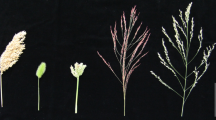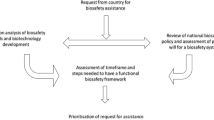Abstract
Orphan crops are critical to developing country strategies for poverty alleviation. However, some productivity constraints of orphan crops cannot be addressed by conventional research, but potentially through genetically modified (GM) crops. These undergo biosafety regulatory assessment in-country. Significant scientific and regulatory gaps exist for orphan crops, potential genes, and transformation protocols. Biosafety assessments of orphan crops may require generation of new information. This becomes difficult if extensive new data is asked for during research, especially for public sector institutions in developing countries investing in GM technologies. We propose alternative approaches to help orphan crops move forward in their testing and development, achieving safety goals, while taking into account the limited resources available for this effort.
Access this chapter
Tax calculation will be finalised at checkout
Purchases are for personal use only
Preview
Unable to display preview. Download preview PDF.
Similar content being viewed by others
References
Atanassov, A., A. Bahieldin, J. Brink, M. Burachik, J.I. Cohen, V. Dhawan, R.V. Ebora, J. Falck-Zepeda, L. Herrera-Estrella, J. Komen, F.C. Low, E. Omaliko, B. Odhiambo, H. Quemada, Y. Peng, MJ. Sampaio, I. Sithole-Niang, A. Sittenfeld, M. Smale, Sutrisno, R. Valyasevi, Y. Zafar, and P. Zambrano. 2004. “To Reach the Poor: Results from the ISNAR-IFPR1 Next Harvest Study on Genetically Modified Crops, Public Research, and Policy Implications.” EPTD Discussion Paper No. 116, Environment and Production Technology Division, International Food Policy Research Institute, Washington, D.C.
Cohen, J.I. (ed.) 1999. “Managing Agricultural Biotechnology.” Wallingford, UK: CAB1 Publishing.
____. 2005. “Poorer Nations Turn to Publicly Developed GM Crops.” Nature 23(1): 27–33.
DiMasi, J.A., R.W. Hansen, and H.G. Grabowski. 2003. “The Price of Innovation: New Estimates of Drug Development Costs.” Journal of Health Economics 22(2): 151–185.
Department of Biotechnology — India. 1998. “Revised Guidelines for Research in Transgenic Plants and Guidelines for Toxicity and Allergenicity of Transgenic Seeds, Plants and Plant Parts.” Department of Biotechnology, Ministry of Science and Technology, Government of India, New Delhi.
Eyzaguirre, P., S. Padulosi, and T. Hodgkin. 1999. “IPGRI’s Strategy for Neglected and Underutilized Species and the Human Dimension of Agrobiodiversity.” In S. Padulosi, ed., Priority Setting for Underutilized and Neglected Plant Species of the Mediterranean Region (report of the IPGRI Conference, February 9–11, 1998, in Aleppo, Syria). International Plant Genetic Resources Institute, Rome, Italy.
Falconi, C. 1999. “Agricultural Biotechnology Research Capacity in Four Countries.” ISNAR Discussion Paper No. 42, International Service for National Agricultural Research, The Hague, the Netherlands.
Food and Agricultural Organization. 2004. “State of Food and Agriculture 2003–2004.” FAO Agriculture Series No. 35, Food and Agriculture Organization of the United Nations, Rome, Italy.
Global Forum on Agricultural Research (GFAR). 2001. “Under-utilized and Orphan Species and Commodities — A Global Framework for Action.” A position paper of the GFAR-UOC Secretariat, Rome, Italy
Hancock, J.F. 2003. “A Framework for Assessing the Risk of Transgenic Crops.” BioScience 53(5): 512–519.
Huang, J., Q. Wang, Y. Zhang, and J. Falck-Zepeda. 2001. “Agricultural Biotechnology Research Indicators: China.” ISNAR Discussion Paper, No. 01-5, International Service for National Agricultural Research, The Hague, the Netherlands.
Isaac, G. E. 2004. “The Interaction Between Levels of Rule Making in International Trade and Investment: The Case of Sanitary and Phytosanitary Measures.” Discussion paper prepared for the “Workshop on the Interaction Between Levels of Rule Making in International Trade and Investment UNU CRIS/LSE ITPU Project” in Brussels, Belgium, December.
Naylor, R.L., W.P. Falcon, R.M. Goodman, M.M. Jahn, T. Sengooba, H. Tefera, and RJ. Nelson. 2004. “Biotechnology in the Developing World: A Case for Increased Investments in Orphan Crops.” Food Policy 29(1): 15–44.
Naylor, R.L., R. Nelson, W. Falcon, R. Goodman, M. Jahn, J. Kalazicgh, T. Sengooba, and H. Tefera. 2002. “Integrating New Genetic Technologies Into the Improvement of Orphan Crops in Least Developed Countries” Paper presented at the 6th International ICABR (International Consortium on Agricultural Biotechnology Research) Conference on Agricultural Biotechnologies: New Avenues for Production, Consumption and Technology Transfer, July 11–14, in Ravello, Italy.
Odhiambo, B. 2002. “Products of Modern Biotechnology Arising from Public Research Collaboration in Kenya.” Paper presented at the conference “Next Harvest — Advancing Biotechnology’s Public Good; Technology Assessment, Regulation and Dissemination,” October 7–9, International Service for National Agricultural Research, The Hague, the Netherlands.
Padulosi, S., T. Hodgkin, J.T. Williams, and N. Haq. 2002. “Underutilized Crops: Trends, Challenges and Opportunities in the 21st Century.” In J.M.M. Engels, V.R. Rao, A.H.D. Brown, and M.T. Jackson, eds., Managing Plant Genetic Diversity. Oxon, UK: CABI Publishing.
Pray, C.E., P. Bengali, and B. Ramaswami. 2004. “Costs and Benefits of Biosafety Regulation in India: A Preliminary Assessment.” Paper presented at the 8th ICABR (International Consortium on Agricultural Biotechnology Research) Conference, July 8–11, Ravello, Italy.
Quemada, H. 2003. “Developing a Regulatory Package for Insect Tolerant Potatoes for African Farmers: Projected Data Requirements for Regulatory Approval in South Africa.” Paper presented at the symposium “Strengthening Biosafety Capacity for Development,” June 9–11, Dikhololo, South Africa.
Sampaio, M.J. 2002. “Ag-Biotechnology GMO Regulations/IP Progresses and Constraints.” Paper presented at the conference “Next Harvest — Advancing Biotechnology’s Public Good: Technology Assessment, Regulation and Dissemination,” October 7–9, International Service for National Agricultural Research, The Hague, the Netherlands.
Secretariat of the Convention on Biological Diversity. 2000. “Cartagena Protocol on Biosafety to the Convention on Biological Diversity: Text and Annexes.” Secretariat of the Convention on Biological Diversity, Montreal, Quebec. Available online at http://www.biodiv.org/doc/legal/cartagena-protocol-en.pdf (accessed July 28, 2005).
Sittenfeld, A. 2002. “Agricultural Biotechnology in Costa Rica: Status of Transgenic Crops.” Paper presented at the conference “Next Harvest — Advancing Biotechnology’s Public Good: Technology Assessment, Regulation and Dissemination,” October 7–9, International Service for National Agricultural Research, The Hague, the Netherlands.
Taylor, N., L. Kent, and C. Fauquet. 2000. “Progress and Challenges for the Deployment of Transgenic Technologies in Cassava.” AgBioForum 7(1&2): 51–56.
Torres, R., and C. Falconi. 2000. “Agricultural Biotechnology Research Indicators: Colombia.” ISNAR Discussion Paper No. 00-5, International Service for National Agricultural Research, The Hague, the Netherlands.
Williams, J.T., and N. Haq. 2002. “Global Research on Underutilized Crops: An Assessment of Current Activities and Proposals for Enhanced Cooperation.” International Centre for Underutilised Crops, Southampton, UK.
Wu, F., and W.P. Butz. 2004. “The Future of Genetically Modified Crops: Lessons from the Green Revolution.” RAND Corporation Monograph Series MG-161, RAND Corporation, Santa Monica, California.
Author information
Authors and Affiliations
Editor information
Editors and Affiliations
Rights and permissions
Copyright information
© 2006 Springer Science+Business Media, LLC
About this chapter
Cite this chapter
Zepeda, J.F., Cohen, J.I. (2006). Biosafety Regulation of Genetically Modified Orphan Crops in Developing Countries: A Way Forward. In: Just, R.E., Alston, J.M., Zilberman, D. (eds) Regulating Agricultural Biotechnology: Economics and Policy. Natural Resource Management and Policy, vol 30. Springer, Boston, MA. https://doi.org/10.1007/978-0-387-36953-2_23
Download citation
DOI: https://doi.org/10.1007/978-0-387-36953-2_23
Publisher Name: Springer, Boston, MA
Print ISBN: 978-0-387-36952-5
Online ISBN: 978-0-387-36953-2
eBook Packages: Biomedical and Life SciencesBiomedical and Life Sciences (R0)




